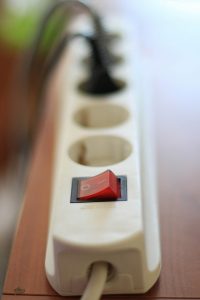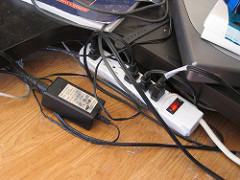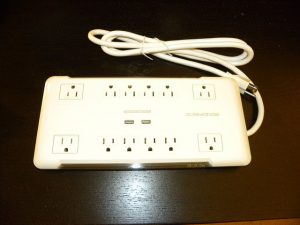
Photo by Tom Raftery
Protect your projector from power failures
Do you know the difference between a surge protector or power strip? When it comes to keeping your projector safe, it’s good to know how to choose between a simple power strip and a surge protector.
Like most electronics with sophisticated optics, projectors can be damaged when jolted back to life after an electrical failure.
Bad weather can result in power spikes when electricity becomes unstable and there is a very high increase in power that last for less than a second. But that small increase is enough to trip breakers, short circuits and cause power outages.
The best protection against electrical damage is to use a surge protector. This is not your ordinary power strip but can sometimes look the same. However, there is a big difference between a surge protector and a power strip.
Differences

Photo by Jon Lesser
While a surge protector may resemble a power strip and work in the same manner, it does offer more protection. Inside are series of metal-oxide varistors (MOVs) that take the electrical hit rather than your projector. A surge protector with a healthy supply of MOVs regulates the voltage by either blocking or grounding excess voltage while also preventing electrical surges coming from a wall outlet. It’s definitely a great investment.
What to look for

Photo by tsilb
Surge protectors are not that much more expensive that an ordinary power bar and do a great job of preventing damages to your projector. The average price is between $10 and $20 — slightly more than what you would pay for a power bar. A good rule of thumb is to always buy slightly more outlets that what you need. This way you can add future gear to the protector and resist the urge to daisy chain plug one on top of another.
There are three parts to consider while buying your surge protector:
- High absorption: Energy absorption is measured in joules and lets you know how much energy the surge protector can absorb before it blows out. The higher the number, the more protection offered. Average ratings are between 200 to 400 joules but for the best protection go for a rating between 600-700 joules. Don’t cheap out on this. It’s worth spending a few extra dollars for a higher joule rating.
- Low voltage: Clamping voltage is how much voltage will make the MOVs send the electricity to the ground line. For clamping you want a low number, somewhere between 300 to 400 volts. Anything higher isn’t going to offer much grounding at all.
- Quick response: You want a surge protector with a quick response time. If it’s got a rating higher than one second it’s not going to offer you protection at that crucial moment. Most electrical surges take less then two seconds to fry your projector. So look for a surge protector with response time less than one second and if possible less than one nanosecond.
Ignore the claims that some manufacturers put on surge protectors claiming to “condition” the power from the wall to improve performance. Most projectors already have this function installed in their hardware.
Need to replace
Surge protectors don’t last forever. They will eventually wear out like all consumable electronic goods. Look for a protector with the red indicator light that shows all the protective MOVs and other components are in good working condition. If you do experience a big power surge, then chances are the MOVs will stop functioning. An indicator light lets you know when your MOVs are done and it’s time to buy a new surge protector.
Surge protectors are a great investment to protect the life of your projector. Read more about the best surge protectors on the market from The Wirecutter’s consumer test.

